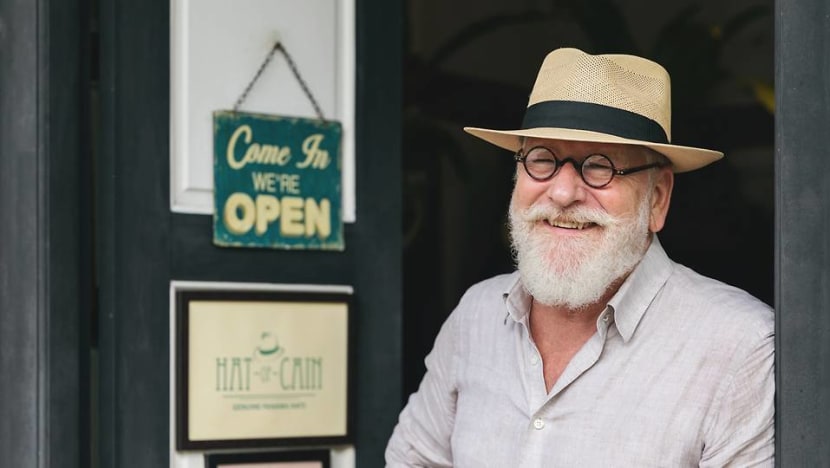Creative Capital: How this former optician started a Panama hat business in Singapore
Long-time expatriate Bill Cain moved to Singapore in 1989 and has been here ever since. He says that Singapore is most ideal to wear a Panama hat, with its perennial summer and being on the same latitude as Ecuador.

Bill Cain (Photo: Hat Of Cain)
Bill Cain is a dapper man. With his white beard and ubiquitous Panama hat on his head, he reminds me of Ernest Hemingway. Like Hemingway, Bill is a long-time expatriate, having left his native Canada – because he hated the cold – back in 1981. He moved to Singapore in 1989 and has been here ever since.
Bill has always loved hats. Wearing one was something his father did, and something that became one of Bill’s own style signifiers when he came an adult. The Panama hat, being lightweight and cooling, is arguably the most sensible hat for the tropics. But try as he might, Bill could not find one regionally that met his standards.
Bill’s career was in the mobility and relocation businesses. That meant a lot of travel and as well as access to other businesses around the world. A decades-long hunt for the best possible Panama hat eventually led him to Ecuador. This then led to the establishment of Hat of Cain in 2012.
READ: The ceramic artist who wants Singaporeans to embrace the beauty of time through handmade things
Throughout the infancy stages of the brand, Bill focused on building a strong supply chain of distributors who sourced from the finest weavers in Ecuador. After six years, and confident that Hat of Cain was producing some of the very best hats on the market, Bill decided to retire from his day job and focus entirely on Hat of Cain.
Mobility wasn’t Bill’s first vocation actually. Before he left Canada, he was an optician. When we met, he told me one of the things he loves most about his current job actually harkens back to those days as an optician. He enjoys making people feel good and confident through their accessories. For him, seeing a customer beam when putting on the perfect hat is akin to helping someone discover the right spectacles that suit his or her face and personality.
To check out the collection, head over to Bill’s salon along Joo Chiat Road. You’ll most likely find him there savouring a fine whisky and cigar, planning his next collection of hats.
OF ALL THE MANY THINGS IN THE WORLD, HOW DID YOU END UP WANTING TO OWN A HAT COMPANY?
I was preparing to exit the corporate world after being in the moving industry for 30 years. Back in the day when I was an optician, I enjoyed making people look and feel good about themselves with great products that I fully believed in. I’ve always loved hats and not being able to buy a good quality hat in Asia prompted me to do something about it.
WHAT WERE THE FAMILY AND FRIENDS’ REACTION TO YOU STARTING THE BUSINESS?
My wife, Charlotte, knew about my love for Panama hats and encouraged me to follow my passion. And to do something about it. Over breakfast with the family one day in 2012, we put our thinking caps on and decided go for it. We set up a company and aptly named it Hat of Cain. From there, my daughter and son-in-law assisted with designing the logo and website. The business was up and running in no time, thanks to the great support from family and friends.
PLEASE TELL ME MORE ABOUT PANAMA HATS? WHAT IS THEIR HISTORY AND ARE ALL PANAMA HATS FROM PANAMA?
The history of the iconic Panama hat should be fairly straight forward. Or so one would think. As far back as the 16th century, the making of Panama hats centered around a cottage industry within the coastal communities of Ecuador. In the 19th Century, the straw hats were traded through the Isthmus in Panama. That was the gateway to the eastern United States and Europe where their popularity grew thanks in part to visiting hat-makers. Well-dressed men and women in the USA and Europe were captivated by these finely woven hats. The hats were coined the “Panama hat” on account of their point of trade rather than their country of origin.
READ: How this former banker-teacher became a woodworker that handcrafts heirloom furniture
When Theodore Roosevelt was photographed wearing a Panama hat whilst visiting the construction of the Panama Canal, he instantly elevated the image of the Panama hat with its signature black band across its circumference to iconic status. From then on, this became the epitome of elegance and sophistication amongst the social elite, part of their de rigueur attire in their pursuit for new world domains and territories. Its popularity grew and this trademark look found its way into popular media and culture through films as personified by the silver screen’s heroes and adventurers.
WHAT SETS A HIGH QUALITY PANAMA HAT APART FROM OTHERS? HOW CAN A LAYPERSON TELL?
The best way to draw a comparison is to regard the Panama hats like fine carpets; the finer the weave the longer it takes to produce and the more valuable. On closer inspection, you can discern the subtle difference in texture and fineness of straw.
There are as many as fifteen people involved in the process of making a Panama hat. It begins with harvesting the shoots from the Carludovica (toquilla) palm which are grown on the coastal region of Ecuador. The shoots are cooked in boiling water as this process will cause the green shoots to lose their colour. They are then cured in sulphur before leaving them to dry out under the sun.
READ: The man who turns boring concrete into beautiful furniture in Singapore homes
The straws are then handed over to the weavers. Depending on the fineness of the intended hat, the weavers will split the straw accordingly. Once the straws are fully woven, the hoods are then sold to exporters where the hats are blocked into shape. The hats are given finishing touches such as sewing of the sweatband and headband and therefore ready for export globally.
IS SINGAPORE A HAT-WEARING COUNTRY?
Singapore is most ideal to wear a Panama hat, with its perennial summer and being on the same latitude as Ecuador. Panama hats are great for sun protection. And they give you that extra bit of style.
I’VE HEARD SOME PEOPLE SAY THAT THEY JUST DON’T LOOK GOOD IN HATS. WHAT’S YOUR TAKE ON THIS?
I think everyone can look good in a hat, given the right style and fit. People often say they don’t look good in a hat because they might have not gotten the right advice on what is suitable and the correct fit. There is a hat out there for everyone, it just takes a little more time to find that perfect hat.
I usually say, “Well, let’s try on a few styles just for fun!” In most cases, we are able to find one that is just right!
WHAT HAS BEEN THE TOUGHEST CHALLENGE RUNNING HAT OF CAIN THAT YOU’VE HAD TO OVERCOME?
Introducing the Panama hat to Singapore and the regional markets before the social media wave. It was a lot of work to create and increase awareness of the hat’s history, culture and tradition and the artisanal efforts that go into making these beautiful products. In 2016, these artisans received their much deserved recognition when UNESCO inducted them into its list of Intangible Cultural Heritage of Humanity. That helped a lot!
READ: The Singaporean tattoo artist making his mark in the world
AND WHAT HAS BEEN THE PROUDEST?
Having my own hat salon and the recognition of Hat of Cain as the go-to hat brand in Singapore. Reading the reviews on Tripadvisor, Google and other social media platforms. I am grateful for the social media exposure the brand has received from people wearing our hats and tagging us in their travel adventures.
WHERE CAN PEOPLE FIND YOUR HATS? ARE YOU AVAILABLE GLOBALLY OR JUST HERE IN SINGAPORE FOR NOW?
We are stocked in several locations around Singapore such as selected Benjamin Barker outlets, the Raffles Hotel, Six Senses Maxwell, Metro Paragon and Tanjong Beach Club.
Our hats are also available at Nihi Sumba Resort, Sanchaya, Nikoi and Cempadek islands in Indonesia and the Tavern in Denmark. We ship globally for those who can’t visit us in Singapore.
WHO ARE YOUR CORE CUSTOMERS? HOW DO PEOPLE FIND YOU?
Our customer base is a mix of locals, expats and tourists. Most people find us via social media, through word-of-mouth and Google.
I NOTICED YOU OFFER BESPOKE SERVICES. IS THIS POPULAR? DO YOU GET EXTREME OR OUT-OF-THE-BOX REQUESTS?
We offer customisation across colours and grades; this usually takes up to four months. But our most popular customisation involves changing the headband to the customer’s favourite colour, debossing their initials and adding feathers. Fortunately, those things can be done within 20 minutes.
We do have customers who like one-of-a-kind hats and that gives me a chance to be creative. I torch hats, add nails, matches, cut and re-stitch them to give them that vintage look.
YOU’VE BEEN HERE FOR THREE DECADES NOW. HOW HAS SINGAPORE CHANGED IN THE YEARS YOU’VE BEEN HERE?
When I first visited Singapore in 1981, the only places you could go to enjoy a beer or Western cuisine were either the hotels or the membership clubs. Look at Singapore today, hosting Michelin-starred restaurants, world renowned rooftop bars... Singapore continues to set the bar for the best living standards not only in Asia but for the rest of the world when it comes to lifestyle, health and personal security, making Singapore a very desirable and cosmopolitan city to live in.
DO YOU THINK SINGAPORE IS WELCOMING OF CREATIVE ENTREPRENEURS? IS IT HARD TO BUILD A BRAND FROM SCRATCH HERE?
Singapore is a great place for entrepreneurs to be based in because of its effective business infrastructure and advanced e-commerce support. It has been very successful in attracting a lot of foreign talent to make Singapore their business headquarters. However, we fall behind our neighbouring countries when it comes to embracing and recognising our local, talented, creative entrepreneurs. The typical expectation of a career here is to excel in the corporate world and creative takes a back seat.
READ: The man behind National Gallery Singapore's logo and why he's a hit
In my opinion, building a brand from scratch takes persistence and discipline. The key is to keep a healthy balance sheet and grow a community of like-minded people who will appreciate your business as they become your brand ambassadors.
YOUR WIFE STARTED BOUTIQUE FAIRS BACK IN 2002, MAKING YOU BOTH BIG SUPPORTERS OF SMALL BUSINESSES HERE IN SINGAPORE. FROM BOTH YOUR PERSPECTIVES, WHAT’S YOUR TAKE ON THE LIFE CYCLE OF INDEPENDENT LIFESTYLE BRANDS?
Independent lifestyle brands can have longevity if they have the right product, a sound business model and the right positioning and branding that resonate with the right target audiences. There are increasingly more independent lifestyle brands than there were 10 years ago. E-commerce and pop-ups such as Boutique Fairs have been a boon to these up and coming independent brands as they give small businesses a head start while keeping overheads low yet giving them a platform to connect and interact with their customers.
WHAT DOES IT TAKE TO MAKE A YOUNG INDEPENDENT RETAIL BRAND SUCCESSFUL?
It takes vision and a solid business plan, you need to find the niche that will set your brand apart and have the drive and most of all healthy working capital.
DOES YOUR FAMILY FEEL MORE SINGAPOREAN OR CANADIAN?
We have lived in Singapore over 30 years. Raising two daughters here and living here for most part of our lives has actually made this our home. Not Canada.















